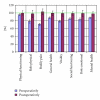Registration of health-related quality of life in a cohort of patients undergoing cholecystectomy
- PMID: 21991514
- PMCID: PMC3168850
- DOI: 10.5402/2011/507389
Registration of health-related quality of life in a cohort of patients undergoing cholecystectomy
Abstract
Background. Assessment of gallstone surgery's impact on quality of life (QoL) requires a reliable instrument with sufficient responsiveness. The instrument should also enable estimation of each individual's expected condition in an unaffected state. Materials and Methods. The Swedish Register for Gallstone Surgery and ERCP (GallRiks) registers indications, complications, results, and QoL-outcome of gallstone surgery. In 2008, 68 hospitals were registered in GallRiks. Between 2007 and 2008, SF-36 (a short form health survey) was filled in 1-2 weeks pre- and 6-9 months postoperatively at five of the units. Expected scores were determined from an age- and gender-matched Swedish population (AGMSP). Results. Of the 330 patients, 212 responded to SF36 pre- and postoperatively (RR = 64%; 212/330). Standardized response means ranged from 0.20 to 0.93 for the SF-36 subscores. Highest responsiveness was seen for bodily pain. Preoperatively, all subscores were significantly lower than in the AGMSP (all P < .05). Six months postoperatively, there was no significant difference between any of the observed and expected quality of life subscales. Conclusion. SF-36 is a useful instrument for measuring the impact of gallstone surgery on QoL. The postinterventional health status equalled or even exceeded the AGMSP for all subscales.
Figures
Similar articles
-
Health-Related Quality-of-Life in a cohort undergoing cholecystectomy.Ann Med Surg (Lond). 2015 Jan 8;4(1):22-5. doi: 10.1016/j.amsu.2014.11.002. eCollection 2015 Mar. Ann Med Surg (Lond). 2015. PMID: 25685340 Free PMC article.
-
The Swedish Registry of Gallstone Surgery and Endoscopic Retrograde Cholangiopancreatography (GallRiks): A nationwide registry for quality assurance of gallstone surgery.JAMA Surg. 2013 May;148(5):471-8. doi: 10.1001/jamasurg.2013.1221. JAMA Surg. 2013. PMID: 23325144
-
The impact of pain frequency, pain localization and perceived cause of pain on quality of life after cholecystectomy.Scand J Gastroenterol. 2017 Dec;52(12):1391-1397. doi: 10.1080/00365521.2017.1369564. Epub 2017 Aug 28. Scand J Gastroenterol. 2017. PMID: 28847183
-
Quality-of-life assessment of morbidly obese patients who have undergone a Lap-Band operation: 2-year follow-up study. Is the MOS SF-36 a useful instrument to measure quality of life in morbidly obese patients?Obes Surg. 2001 Apr;11(2):212-8; discussion 219. doi: 10.1381/096089201321577901. Obes Surg. 2001. PMID: 11355029
-
Outcome assessment in lumbar spine surgery.Acta Orthop Suppl. 2005 Jun;76(318):5-47. Acta Orthop Suppl. 2005. PMID: 16175972 Review.
Cited by
-
Effects of Intra-abdominally Instilled Isotonic Saline on Pain, Recovery, and Health-Related Quality-of-Life Following Laparoscopic Cholecystectomy: A Randomized Prospective Double-Blind Controlled Study.World J Surg. 2015 Jun;39(6):1413-20. doi: 10.1007/s00268-015-2978-8. World J Surg. 2015. PMID: 25665674 Clinical Trial.
-
Patient-centered outcomes after laparoscopic cholecystectomy.Surg Endosc. 2013 Dec;27(12):4491-8. doi: 10.1007/s00464-013-3095-0. Epub 2013 Aug 13. Surg Endosc. 2013. PMID: 23943114
-
Patient-reported outcome measures to evaluate postoperative quality of life in patients undergoing elective abdominal surgery: a systematic review.Qual Life Res. 2022 Aug;31(8):2267-2279. doi: 10.1007/s11136-021-03071-1. Epub 2022 Jan 22. Qual Life Res. 2022. PMID: 35064414
-
Health-Related Quality-of-Life in a cohort undergoing cholecystectomy.Ann Med Surg (Lond). 2015 Jan 8;4(1):22-5. doi: 10.1016/j.amsu.2014.11.002. eCollection 2015 Mar. Ann Med Surg (Lond). 2015. PMID: 25685340 Free PMC article.
-
A systematic review of patient reported outcome measures (PROMs) and quality of life reporting in patients undergoing laparoscopic cholecystectomy.Hepatobiliary Surg Nutr. 2019 Jun;8(3):228-245. doi: 10.21037/hbsn.2019.03.16. Hepatobiliary Surg Nutr. 2019. PMID: 31245403 Free PMC article. Review.
References
-
- Borch K, Jönsson K, Zdolsek JM, Halldestam I, Kullman E. Prevalence of gallstone disease in a Swedish population sample: relations to occupation, childbirth, health status, life style, medications, and blood lipids. Scandinavian Journal of Gastroenterology. 1998;33(11):1219–1225. - PubMed
-
- Sakorafas GH, Milingos D, Peros G. Asymptomatic cholelithiasis: is cholecystectomy really needed? A critical reappraisal 15 years after the introduction of laparoscopic cholecystectomy. Digestive Diseases and Sciences. 2007;52(5):1313–1325. - PubMed
-
- Aggarwal S, Senapati PSP. Predictors of improvement in health-related quality of life in patients undergoing cholecystectomy. British Journal of Surgery. 2004;91(4):p. 510. - PubMed
-
- Johanning JM, Gruenberg JC. The changing face of cholecystectomy. American Surgeon. 1998;64(7):643–648. - PubMed
-
- Topçu O, Karakayali F, Kuzu MA, et al. Comparison of long-term quality of life after laparoscopic and open cholecystectomy: a case-control study. Surgical Endoscopy and Other Interventional Techniques. 2003;17(2):291–295. - PubMed
LinkOut - more resources
Full Text Sources


